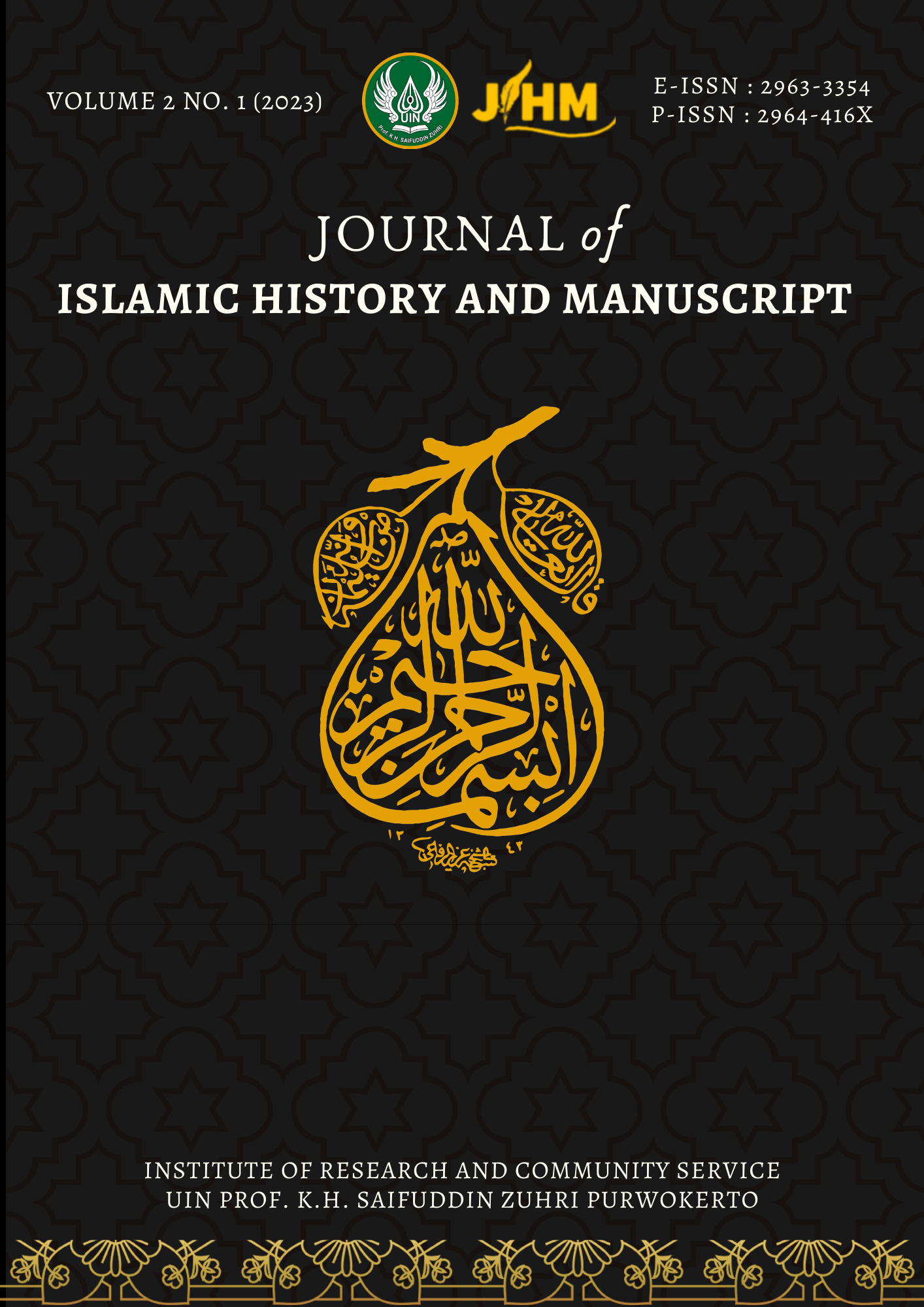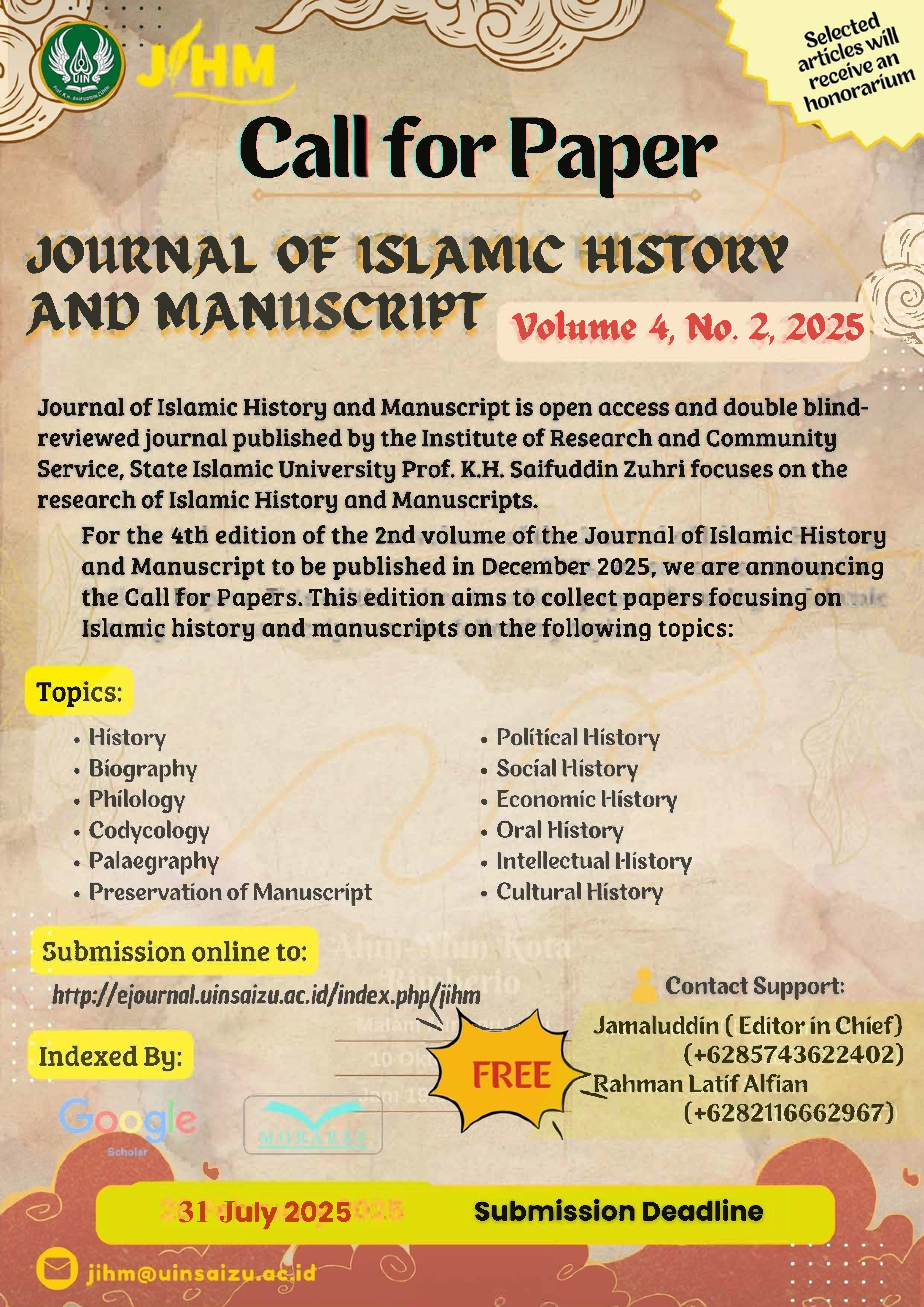The Hanafi School of Islamic Jurisprudence Literature: A Historical Account
DOI:
https://doi.org/10.24090/jihm.v2i1.7788Keywords:
Mujtahid, Islamic Jurisprudence, Literature, Historical, Abu HanifahAbstract
This article focuses on one of the founding figures of the Sunni school of Islamic jurisprudence who contributed to the development of Islamic law, Abu Hanifah. Studying Abu Hanifahs literature can better understand his thoughts and views on Islamic legal issues. It can also provide greater insight into the history of Islamic thought and how Abu Hanifahs thoughts impact Muslim society today. This study uses the heuristic method with critical literature analysis because the data is obtained from various books, journals, and other documentation relevant to the historical approach. The results of this study state that the Hanafi school of Islamic jurisprudence is one of the famous schools of Islamic jurisprudence in the scientific discipline of Islamic law founded by Abu Hanifah. His background and education strongly influence Abu Hanifahs thinking pattern in determining the law. It is also inseparable from the socio-cultural dimension and the politics that underlie the Hanafi school of Islamic jurisprudence, which is seen as a factor affecting Islamic laws rational character. Literature on studying Islamic law in the Hanafi school of Islamic jurisprudence is widely found and spread worldwide. The school of Islamic jurisprudence is even adopted by one-third of the worlds Muslim population. However, remember that some of Abu Hanifahs written works may no longer be available or incomplete. Over time, some manuscripts may be damaged or lost.References
Abdullah Mustofa al-Maraghi. (2001). Pakar-pakar Fiqih Sepanjang Sejarah. Yogyakarta: LKPSM.
Ahmad Amin. (1975). Fajrul Islam. Kairo: Maktabatun Nahdlatil Mishriyah.
Ahmad Asy-Syurbasi. (2008). Sejarah dan Biografi Empat Imam Mazhab. Jakarta: Amzah.
ARSLAN, A. (2020). Imam Azam Ebu Hanifenin ( 150/767) Ilim Anlayisi, Ilimleri Taksimi ve Hadis Ilmine Bakisi. Ondokuz Mayis Universitesi Ilahiyat Fakultesi Dergisi, (49), 79–106. https://doi.org/10.17120/omuifd.789721
Ayoub, S. (2015). The Mecelle, Sharia, and the Ottoman State: Fashioning and refashioning of Islamic law in the nineteenth and twentieth centuries. Journal of the Ottoman and Turkish Studies Association, 2(1), 121–146.
Beser, F. (2004). Ebu Hanifenin Kuran Anlayisi. Usul Islam Arastirmalari, 1(1).
Djazuli. (2010). Kaidah-Kaidah Fikih, Kaidah-Kaidah Hukum Islam dalam Menyelesaikan Masalah-masalah yang Praktis. (3, Ed.). Jakarta: Prenada Media Group.
Esposito, J. L. (1976). Muslim family law reform: Towards an Islamic methodology. Islamic Studies, 15(1), 19–51.
Hanife, E. (2017). el-Alim vel-Muteallim. cev. Mustafa Oz. Imam-i Azamın Bes Eseri. Istanbul: Marmara Universitesi Ilahiyat Fakultesi Vakfi Yayinlari, 13.
Hanife, E. (2011). Numan b. Sabit. el-Fikhul-Ekber. Imam-i Azamin Bes Eseri, 69–77.
Hanife, E., & Azam, I. (2011). el-Fıkhul-Ekber, terc. Mustafa oz (Imam-i Azamin Bes Eseri Icinde),(Istanbul: IFAV Yayinlari).
Hasan, K. (2011). Imam-I Azam Ebu Hanifenin bes Eserinde Imanla iliskili temel
kavramlar. Ondokuz Mayis Universitesi Ilahiyat Fakultesi Dergisi, 30(30), 89–118.
Hasyim Fathoni. (2013). Pemikiran Hukum Islam Imam al-Bukhari. Yogyakarta: Pustaka Pelajar.
Juliansyahzen, M. I. (2015). PEMIKIRAN HUKUM ISLAM ABU HANIFAH: Sebuah Kajian Sosio-Hostoris Seputar Hukum Keluarga. Al-Mazaahib: Jurnal Perbandingan Hukum, 3(1). https://doi.org/10.14421/al-mazaahib.v3i1.1382
Karimullah, S. S. (2022). Pursuing Legal Harmony: Indonesianization of Islamic Law Concept and Its Impact on National Law. Mazahib, 21(2), 213–244. https://doi.org/10.21093/mj.v21i2.4800
Khalil Munawar. (1996). Biografi Empat Serangkai Imam Mazhab. Jakarta: Bulan Bintang.
M. Ali Hasan. (1996). Perbandingan Mazhab (2 ed.). Jakarta: Raja Grafindo Persada.
Makdisi, G. (1979). The Significance of the Sunni Schools of Law in Islamic Religious History. International Journal of Middle East Studies, 10(1), 1–8. https://doi.org/10.1017/S0020743800053277
Mughniyah, M. J. (2012). Fiqih Lima Mazhab (27 ed.). Bandung: Lentera.
Muhammad Mashum Zein. (2008). Arus Pemikiran Empat Mazhab: Studi Analisis Istinbath Para Fuqaha. Jombang: Darul al-Hikmah.
Munim A. Sirry. (1995). Sejarah Fiqih Islam. Surabaya: Risalah Gusti.
Mushtafa Said Alkhin. (1984). Dirasatun Tarikhiyatun lil Fiqh wa Ushulih. Damaskus: Assyirkah Almuttahidah.
Peters, R. (2020). What Does It Mean to Be an Official Madhhab? Hanafism and the Ottoman Empire. In Sharia, Justice and Legal Order (hal. 585–599). BRILL. https://doi.org/10.1163/9789004420625_032
Prawiro, T. (2022). Bahasa dan Akal Dalam Ijtihad Mazhab Hanafi. Jurnal Alasma: Media Informasi dan Komunikasi Ilmiah, 4(2), 148–156.
Schacht, J. (1982). An Introduction to Islamic Law. London: Oxford University Press.
Sopian, A. (2021). Kitab Fiqh Al-Akbar Karya Imam Abu Hanifah. An-Nawa : Jurnal Studi Islam, 3(2), 76–88. https://doi.org/10.37758/annawa.v3i2.313
Soroni, M. K. (2018). Sumbangan Ulama Mazhab Hanafi dalam Pembukuan Ulum Al-Hadith. HADIS, 8(16), 40–62. https://doi.org/https://doi.org/10.53840/hadis.v8i16.3
Soylemez, M. M. (2015). Kufenin Yetisdirdigi Mutebahhir Bir Alim: Imami Azam Ebu Hanife Numan B. SAbit. Yakin Dogu Universitesi Ilahiyat Fakultesi Dergisi, 1(1), 33–47.
Suud Sarim Karimullah. (2022). Shafii Literature in Indonesia: A Historical Account. Islamica: Jurnal Studi Keislaman, 17(1), 1–19. https://doi.org/https://doi.org/10.15642/islamica.2022.17.1.1-19
Taskomur, H. (2019). Books on Islamic Jurisprudence, Schools of Law, and Biographies of Imams from the Hanafi School. In Treasures of Knowledge: An Inventory of the Ottoman Palace Library (1502/3-1503/4)(2 vols) (hal. 389–422). Brill.
Downloads
Published
How to Cite
Issue
Section
License
Copyright (c) 2023 Suud Sarim Karimullah, Arif Sugitanata

This work is licensed under a Creative Commons Attribution 4.0 International License.
Authors who publish in this journal agree to the following terms:
- Authors retain copyright and grant the journal right of first publication with the work simultaneously licensed under a Creative Commons Attribution 4.0 International License. that allows others to share the work with an acknowledgment of the work's authorship and initial publication in this journal.
- Authors can enter into separate, additional contractual arrangements for the non-exclusive distribution of the journal's published version of the work (e.g., post it to an institutional repository or publish it in a book), with an acknowledgment of its initial publication in this journal.
- Authors are permitted and encouraged to post their work online (e.g., in institutional repositories or on their website) before and during the submission process, as it can lead to productive exchanges and earlier and greater citation of published work (See The Effect of Open Access).

















